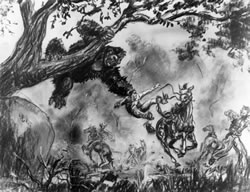
"C'è molta gente che ha
familiarità con titoli come King Kong, Un uomo tranquillo, Sentieri
selvaggi o il procedimento del Technicolor ma non con il nome Merian
C. Cooper", scrive James V. D'Arc nella sua introduzione al Register
to the Merian C. Cooper Papers. "Che questo nome dica poco alle
attuali generazioni, nulla toglie al fondamentale ruolo svolto da colui
che lo portava nel cinema, nell'aviazione, nell'esplorazione. Troppo spesso
andiamo a cercare i nostri eroi nel lontano passato, mentre uno straordinario
uomo rinascimentale ha operato in mezzo a noi per buona parte del XX secolo,
percorrendo le giungle dell'Asia e le regioni montuose di quella che una
volta si chiamava Persia, arruolandosi come pilota nell'Aeronautica militare
americana durante la prima e la seconda guerra mondiale e realizzando
nel contempo alcuni dei film più amati di tutti i tempi.
L'importanza delle collezioni cartacee e delle istituzioni che le
conservano sta nel fatto che esse sono le custodi della memoria storica.
Collezioni come quella di Cooper sono essenziali agli storici per ricordare,
e spiegare, il passato. Fortunatamente, l'esistenza dei Merian C. Cooper
Papers – una preziosa collezione di documenti, pellicole, fotografie,
cimeli – garantisce un'adeguata valutazione storica di Cooper al
di là delle pellicole che recano il suo nome. Egli rimane uno dei
figli più dotati e poliedrici d'America. L'eredità che ci
ha lasciato comprende, in aggiunta a King Kong (ormai un'icona culturale
oltre che cinematografica), un paio di compagnie aeree, la cinematografia
a colori, la creazione della coppia Fred Astaire e Ginger Rogers, il rivoluzionario
Cinerama."
Grazie al figlio di Cooper, l'ex colonnello d'aviazione Richard M.Cooper,
che nel corso degli anni si è adoperato in ogni modo per mettere
assieme i materiali della collezione paterna; grazie all'istituzione che
ora la custodisce, la Harold B. Lee Library della Brigham Young University,
e all'iniziativa del suo curatore, Jim D'Arc, che, oltre ad amorevolmente
conservare, ci tiene a far conoscere i preziosi reperti a lui affidati,
siamo in grado di proporre in questa mostra – casualmente, ma felicemente
proprio nel 70° anniversario della première di King Kong
– alcuni significativi capitoli dell'avventurosa storia umana e
professionale di Merian Coldwell Cooper.
As James
V. D'Arc writes in his introduction to
Register to the Merian C. Cooper Papers, "More people are familiar
with King Kong, The Quiet Man, The Searchers,
and the film process called Technicolor than they are with the name Merian
C.Cooper. That Cooper's name has been largely lost to current generations
does not diminish the significance of his influence on the motion picture
industry, aviation, and exploration. Too often are heroes identified in
fiction of years gone by when, in fact, a remarkable Renaissance-type
man walked and worked among us for much of the 20th century, tracking
through the jungles of Asia and the mountainous areas of what was then
known as Persia, and serving in the United States Air Force during World
Wars I and II, as well as making some of the most revered motion pictures
of all time.
The significance of manuscript collections and the repositories that preserve
them lies in the fact that they are the custodians of historical memory.
Collections like Cooper's are the building blocks upon which historians
will remember-as well as account for-the past. Fortunately, the existence
of the Merian C. Cooper Papers will insure a balanced historical appraisal
of Cooper beyond the motion pictures that bear his name. The availability
of Cooper's rich collection of papers, motion pictures, photographs, and
memorabilia will, it is hoped, allow his unique legacy to become interwoven
once again into the American fabric. He remains, after all, one of this
country's most multi-faceted and gifted sons. His legacy, in addition
to giving us King Kong (by now a cultural as well as cinematic icon),
includes an airline or two, color cinematography, the pairing of Fred
Astaire and Ginger Rogers, and the widescreen process of Cinerama that
revolutionized the shape and sound of motion pictures.
Thanks to Cooper's son, retired United
States Air Force Colonel Richard M. Cooper, who has striven over the years
to ensure that this collection of documents was gathered together, thanks
to the institution which now cares for them, the Harold B. Lee Library
of Brigham Young University, and to the initiative of its curator, James
V. D'Arc, whose concern is not only to preserve the precious records entrusted
to him, but also to make them known, we are proud to offer – by
a happy chance in the 70th anniversary year of the premiere of King
Kong – some significant chapters of the adventurous human and
professional story of Merian Coldwell Cooper.

Mighty Joe Young (Il re dell'Africa), 1949: disegno di Willis O' Brien. In questo film compare in una particina non accreditata anche Primo Carnera. / A production sketch by Willis O' Brien (The Merian C. Cooper Papers).